|
Pfc. Floyd L. Rogers, 2nd Infantry Division, silver star,
November 29, 1919 - July 12, 1944
About WWII Army HBT Uniforms
This page consists of my observations and analysis of authentic WWII garments with some input from Risch and Pitkin's QMC Historical Studies, Clothing the Soldier of WWII.
With over 25 years experience manufacturing reproduction garments, I hope to be able to offer some insights not usually found in typical references. Despite this being one of the most prolific uniforms of the Second World War, and authentic examples being relatively plentiful, the available reference material is surprisingly scant.
Prior to the outbreak of WWII, soldiers in of the US Army were issued a blue denim jumper, trousers, and hat for fatigue duties and used the cotton khaki shirt and trousers as their summer uniform.
By the late 1930's, the Army recognized the need for a more practical uniform in a more suitable color. In 1941, a green uniform made from cotton herringbone twill (HBT) fabric was introduced to replace both the denim and khaki cotton uniforms for work and field operations. Shirts, trousers, coveralls and caps were produced. These garments were issued to all Army personnel in all theaters of operations, ultimately becoming one of the most common garments worn during WWII.
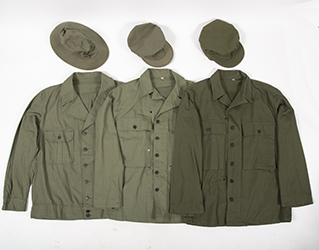
|
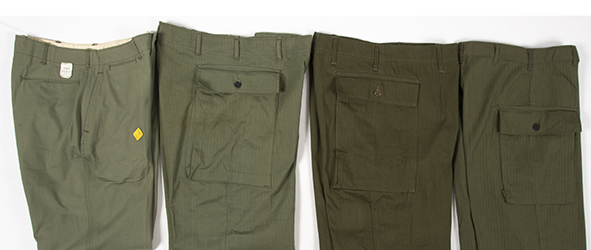
|
|
|
|
L to R: 1st pattern, 2nd pattern light shade, 2nd pattern OD7
|
L to R: 1st pattern, 2nd pattern, 2nd pattern OD7, 2nd pattern April 1, 1944 and later
|
|
|
|
|
|
|
|
|
|
|
|
|
The "First Pattern" HBT
The Army introduced the Two-Piece herringbone-twill work suit in 1941 to replace the creaky denim pants and jumper. This uniform is referred to by collectors as the "first pattern HBT" and the color as "sage green" with both terms being contemporary and were not used by the US Army or QMC in WWII. The actual government name for what is called "sage green" today was OD8. Yes, it and OD7 are out of sequential order.
The first pattern jackets, Spec. Number 45, were waist length, with two pleated breast pockets, an adjustable waist band, and bi-swing back. The trousers were essentially the same pattern as the khaki and wool models with straight legs, four internal pockets, and a watch pocket. Both garments used metal tack buttons for closures.
These uniforms were widely issued and were worn in all theaters of operation until the end of the War. Production of both ran into the Fall of 1942.
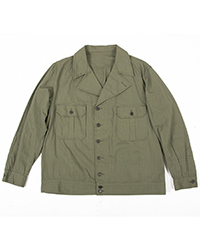
|
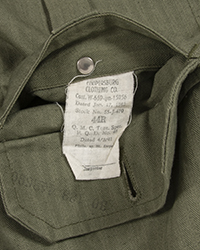
|
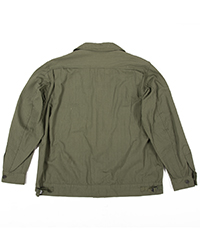
|
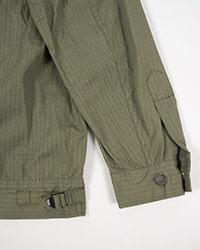
|
|
1st Model Jacket
|
Spec. No. 45, April 1941.
|
Bi-swing back, gusseted armpits,
adjustable waist
|
Cuff and waist detail
|
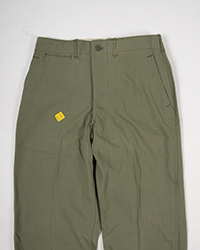
|

|

|

|
|
1st Model Trousers
|
Same pattern as the khaki
trousers
|
Button fly, watch pocket
|
Lining was either white twill
or the HBT (same as the
outside)
|
The Simplified Two Piece Suit
By early 1942, government contractors were struggling to supply enough of the HBT uniforms to supply the needs of the Army. This fact combined with complaints from the troops regarding their design led to the garments being modified in order to simplify production and improve their functional characteristics. New designs for both garments appeared in late 1942- these uniforms are referred to by collectors as "second pattern"- while the Army termed them "simplified two piece suit".
The new jacket was greatly simplified; the bi-swing back, adjustable waist and gusseted armpits were gone, the breast pockets were simpler and much larger. The already loosely fitting chest was enlarged another 2". They were now 10" over the marked size due to the design concept that they be large enough to be worn over a field jacket.
The new trousers had a larger seat for better freedom of movement, a higher rise, and the internal pockets were replaced with two large cargo types on the hips.
The "Specials"
At this point, the Army was going to great lengths to protect troops from possible chemical warfare attack. In late 1942, most tops were modified with "gas flaps" on the chests and cuffs while trousers were fitted with overlapping flys in an effort to prevent blister agents from reaching soldiers' skin. Garments modified or produced with these features had the term "Special" added to their name. The Specials appeared early in 1943, with contracts running concurrently with non-special garments.
The first specification for 2nd pattern jackets did not have a gas flap. This was the 45B which was only made for a brief period at the end of 1942 and into early 1943. In Jan 1943 the first "Special" was approved, the short-lived 45C, (Jan 1943) which was identical to the 45B, except for the addition of the gas flap and buttons under the rear of the collar for an anti-gas hood. In March 1943, this was replaced by the 45D which eliminated the yoke at the shoulders. This model was manufactured through the end of the War in both OD8 (sage green) and OD7. The Quartermaster did differentiate uniforms made in the two colors by assigning them separate stock numbers.
"Special" Trousers made in sage green had Spec numbers 42A (Oct 1942), 42B (Jan 1943), and finally 42C (March 1943)- the latter, like the 45D jackets, was made in both sage green and OD7.
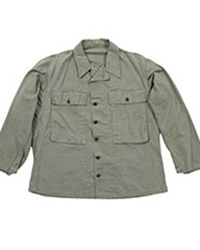
|
|

|
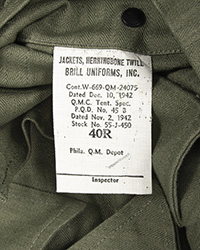
|
Spec 45B- no gas flap, OD8.
|
|
Spec 45B. Note the two piece
back.
|
45B Label.
|
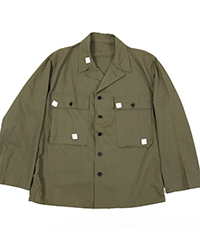
|

|
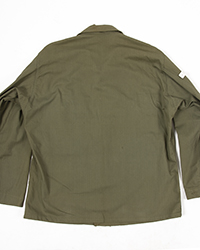
|

|
45B- made with the 45D
one piece back but no
gas flap
|
Inside.
|
One piece back.
|
Label has been edited by hand
at the factory. According to the
stock number this is actually
a Spec 45B jacket- not a 45D
|

|

|
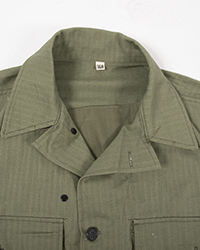
|
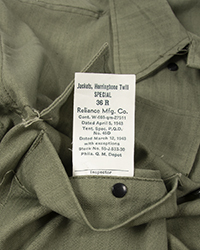
|
|
Spec No. 45D
|
The gas flap
|
The gas flap shown when
closed
|
This pattern was approved
in March, 1943
|
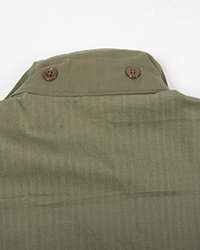
|
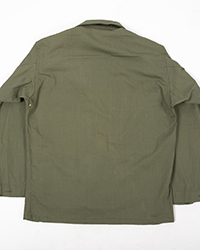
|
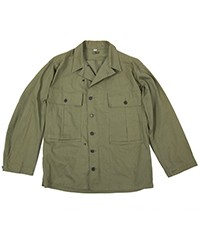
|
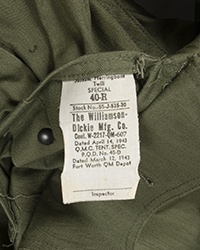
|
Buttons for the hood- both
plastic and metal tack types
were used
|
|
Example with optional
center pleated pockets
|
Spring 1943 production-
no such thing as a "3rd
pattern"
|

|
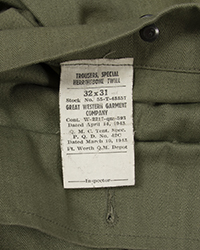
|

|

|
Simplified aka "2nd pattern"
trousers
|
Spec. No. 42C, March 1943
|
Early "high pocket" pattern
|
Overlapping fly acts as a
gas flap
|
|
|
|
|
|
|
|
|
|
|
A New Shade
During 1942, the sage green color was determined to be unacceptable. Even when new, the color was too light for concealment purposes, and use and exposure led to fading, further exacerbating the problem. After lengthy tests and field trials with various colors and camouflage patterns, the OQMG decided on olive drab shade number 7 as the best solution.
The "OD7" uniforms entered production in early 1943. Garments were made in both sage green and OD7 simultaneously due to the Army permitting the manufacturers to use up existing stocks of fabrics before switching to the new color.
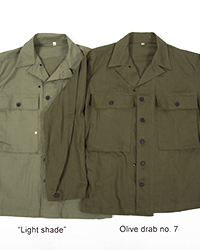
|
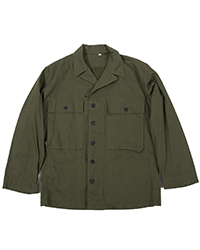
|

|
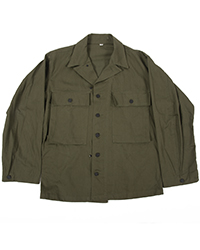
|
The two shades-
olive drab 8 vs. 7 |
A "classic" example of an
OD7 HBT Jacket
|
An early production jacket,
in a more greenish shade
|
...and a more brownish shade
|
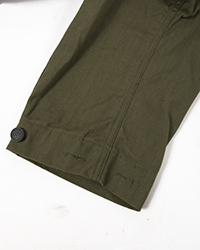
|
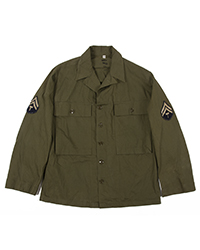
|
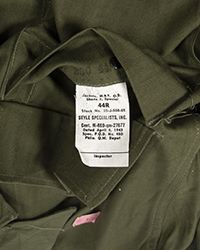
|
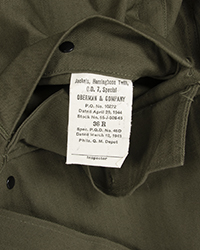
|
|
Cuff detail
|
Plastic button variation
|
Spec 45D, OD7
|
April 1943 pattern date
|
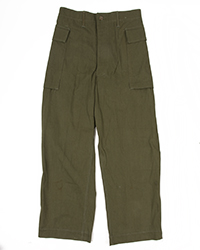
|
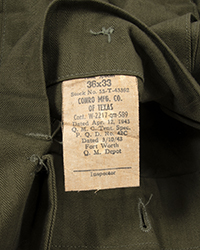
|
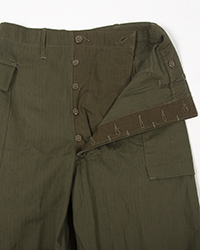
|
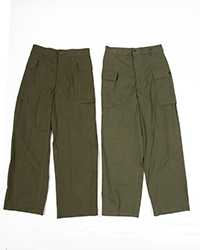
|
|
Pre-April 1944 trousers
|
Spring 1943 production, Spec 42C
|
Notably shaded gas flap- a
somewhat atypical trait
|
Comparison of the pocket
positions
|

|
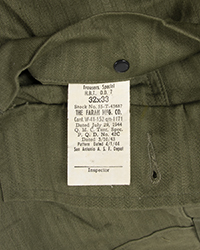
|
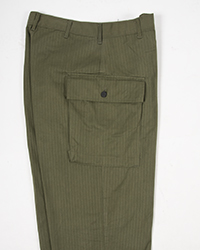
|
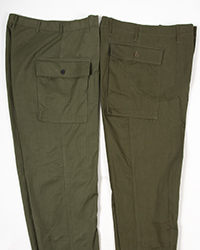
|
|
April 1944 pattern change
|
Spec date 3-43, pattern change
4-44, contract signed 7-44
|
The "new" pocket location
was much more practical
|
Later trousers (L) vs. earlier
production (R)
|
The Pocket Drop
The HBT uniforms would retain this same design throughout the end of the War. In April, 1944, one small change was made to the trousers by lowering the hip pockets 3-4 inches to make them easier to access when the soldier was wearing a field jacket. Due to the late date of this change, it is unlikely that any trousers with the lower pocket position were used during the Normandy Landings in June, 1944.
Manufacture
HBT uniforms- jackets, trousers, coveralls and caps were all made using the same assembly methods as other WWII American uniforms. The parts were cut with power knives or die punched and individually tagged to prevent shading. The contractors used standard lock stitch machines for single seams and two-needle chain stitch models for the felled, interlocking seams. Belt loops and pocket corners were reinforced with bartacks (usually 18 or 28 stitch). Both corded eyelet and standard tacked buttonholes were allowed by the OQMG. Tack buttons were attached with hand or foot presses while plastic buttons were affixed by machine. Spec labels with the item name, size, manufacturer, and contract information were placed in the right hand pocket and woven size labels sewn into the necks, waistbands or sweatbands.
Production Variants
With dozens, perhaps hundreds of firms assembling HBT garments, there are several common variations encountered on authentic WWII examples. Some are due to the Army permitting substitute components or assembly methods due to shortages of materials or equipment, while others simply come with the territory when hundreds of thousands of garments are being made by numerous manufacturers using fabric and parts supplied by hundreds of companies- often as quickly as possible.
The "3rd Pattern" fantasy
On the "second pattern" jackets and trousers, the QMC allowed the manufacturers a choice on how to construct the pockets. They could make them plain front, with an expandable gusset on the outer edge, or sew the edges flat while having a 1" pleat in the center of the pocket. Some enthusiasts have christened HBT uniforms made in the latter style as "3rd pattern" or "Korean War". Neither is true. The pleated pockets were used on both sage green and OD7 uniforms, and the spec labels show production ranging for the entire period (1943-45).
|
|

|

|
|
|
|
The pleats in the center of the pockets were a variation, not a later pattern
|
Both trousers are Spring 1943 production
|
|
|
|
|
|
|
|
|
|
|
|
Buttons & Buttonholes
The most common closures used are black (or occasionally olive drab) metal tack buttons with a 13 star design on the cap. One occasionally finds sage green uniforms made using tack buttons with a hollow center and wreath design in lieu of the 13 star type. Lastly, some uniforms (both sage green and OD7) were made with plastic buttons- sometimes the caramel colored type seen on wool trousers or the OD7 style used on M1943 Field Uniforms.
As with the pleated pockets, uniforms with plastic buttons are often automatically declared to be "Korean War" by less experienced enthusiasts- but the spec labels and photos prove otherwise. The soldier on the far right in the June 1944 photo above clearly has plastic buttons on his jacket. Their use is scattered throughout the range of production dates (1943-45) making them yet another permissible substitution.
Both the standard "bartack" and corded eyelet type buttonholes are found on original garments.
Thread
The thread color was obviously meant to match the fabric- but during the transition from the lighter color to OD7, it's obvious the factories were using up what was already on hand. There are sage uniforms sewn with dark olive drab thread vice versa.
Shading
As with all wartime garments, the shades of sage green and OD7 vary markedly. The sage green can range from nearly a gray to a bizarre green approaching a faded turquoise- very reminiscent of ACU's. The OD7 is likewise quite variable. At times the two colors appear nearly the same depending on the variations on the garments being compared.
|
|
|

|
|
|
|
|
Q: Is that OD7? Or is that OD7???
A: Yes.
|
|
Issue and Wear
The HBT uniform was general issue to all personnel in the US Army thus the number produced was in the millions. The garments were utilized throughout the entire conflict, in all theaters. Wear depended on the weather- in hot climates, this was the primary uniform, worn often by itself. In cooler areas, the HBT's were worn in conjunction with the OD's (wool shirts and trousers) and field jackets. Some units and troops chose to wear the top over their field jackets- the best known photographic example being the 4th Division troops on Utah beach. Others troops wore them underneath other garments.
Jackets were frequently worn tucked in at the waist.
All patterns and both colors were issued and worn through the end of the War, and some were later utilized in Korea.
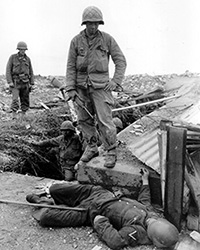
|
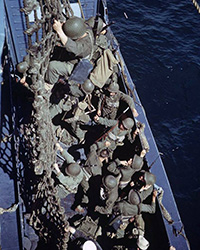
|
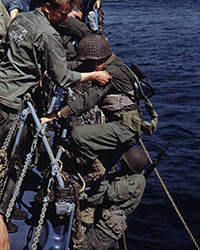
|

|
|
|
Both light and dark shades
clearly used together
|
|
4th Division troops wearing
the HBT top over their field
jackets
|
|
|
|
|
|
|
|
|
|
|
|
|
|
|
|
|
|
|
|
|
|
|
|
|
|
|
|
|
|
|
Concerns for Living History
Models: Which pattern/ color is "correct"? From early 1943 onward all styles were issued and in use. First pattern uniforms were undoubtedly still being worn on VE Day. The second pattern, OD7 uniform (also the most plentiful reproduction) is historically correct for anything from mid-1943 onward. Since 99% of living history is concerned with D-day and afterward, it's an easy choice. All variations were in wear prior to D-day except for the low pocket trousers.
The Pocket: The post April 1944 production trousers were probably not used at D-day. It's within the realm of possibility that some were finished in May and flown over (there were rush air shipments of various critical items constantly being sent to England) but regardless, the vast, vast majority would have had the higher pockets.
Light shade? Dark shade? Which is correct? The most despised answer for Living Historians- BOTH. Sorry.
This jacket is way too big! Blame the US Army. These were designed to be worn over a field jacket- so they are cut 8" oversize on 1st Patterns, and 10" over on "2nd Patterns". (ie: a size 40 HBT jacket has a chest circumference of 48" or 50"). Most men's jackets are 6" or 7" oversized.
Airborne Ranger Short Visor Caps: 100% BS. At the end of the War the QMC issued a new specification lengthening the visor about 1/2". The only change during the War was switching from OD8 (sage green) to OD7 (dark shade).
The pants aren't sexy: This is a common complaint- not a joke. Trousers in the 1940's were not cut like they are today- the rise on WWII pants is, on average, about 2" higher than that found on most modern ones. These were designed by the US Army for engaging in manual labor, military training and combat. Not showing off one's curves at the county fair.
Insignia? Yes or no. Wartime photos exist of these uniforms being worn devoid of rank and unit patches- as well as otherwise. With combat troops, sterile (plain) jackets are far more common.
Honor guards and parades: This was a work/ combat uniform. George S. Patton would likely have snarled at the idea of it being worn for an honor guard, but there was a war on and all manner of distasteful things happened and the grooming standards were undoubtedly violated now and then.
Marines? This is not the USMC Utility uniform. However, wartime stories of the Corps' skill at obtaining Army property abound, and there are a few period photos of Marines wearing Army HBT uniform components. So yes, it happened, but the Marines had their own, specific HBT clothing which was different in cut, weave and color from these.
|